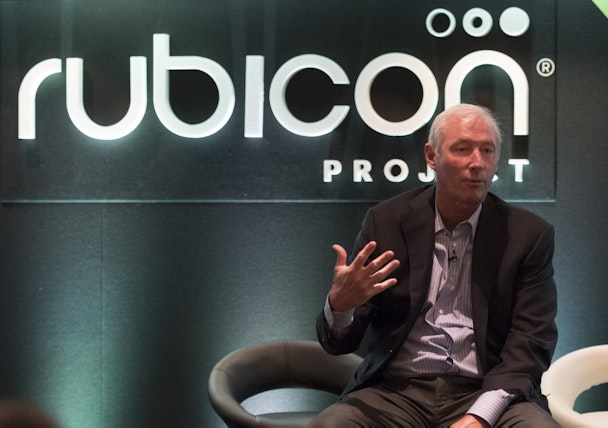Rubicon Project CEO Michael Barrett: ‘What we’re trying to trumpet is choice’
Michael Barrett assumed the role of Rubicon Project chief executive at the most turbulent time in the adtech outfit’s 10-year history this year, and has since gone about affecting some major overhauls to its strategy. He spoke with The Drum on his reasons for casting the die in a world of decreasing adtech margins.

Two-hand take rates are 'three year-old thinking' according to Rubicon Project's Michael Barrett / Rubicon Project
Some of the significant changes since his arrival have been the announcements that it will drop its buy-side fees, opening up to the possibility of auctioning inventory using either first-or-second-price auction models, as well furthering its header bidding offering – a strategy that has seen it partner with others in the sector.
Rubicon’s leadership (both Barrett, and his predecessor Frank Addante) has gone on record as openly conceding that the business was wrong-footed by the rising popularity of header bidding among publishers. Addressing this situation is something that has taken up a lot of his time since taking the role in March this year.
Changes prompted by header bidding
In conversation with The Drum, Barrett reiterates how this trend, in-part, motivated his company’s $38.5m purchase of nToggle – an outfit that aids demand-side platforms (DSP) in processing the resulting up-tick in bid requests ushered-in by header bidding – and one that has seen it reassess its opinion on auction dynamics.
“We had traditionally been a second-price auction shop and with the advent of header bidding we started to really examine the efficacy for buyers and sellers of offering a second price auction in a world where a lot of people were going first price,” he says.
This forms part of Barrett and his leadership team’s commitment to offering both sides of the market transparency – arguably the catch-cry of the digital media sector in 2017 – a strategy that recently saw it announce further developments in its multi-choice auction model, dubbed “Estimated Market Rate” (EMR).
'Estimated Market Rate'
This means that Rubicon will select the winner of all header bidding transactions on its exchanges on a first-price basis; the prospective buyer is then able to choose whether or not it submits this price into the final auction, or a potentially smaller bid estimated using EMR.
This “bid shading” feature looks for opportunities to reduce the cost to buyers, while still helping the buy-side maintain their win-rates, according to Barrett.
He goes on the point out that this need was identified after early tests demonstrated that the buy-side of the industry is not universally ready for abandoning the historic default real-time bidding (RTB) model.
“We had buyers come and say we were not prepared for first-price,” states Barrett, adding that while such auctions are “as simple as it gets” many buy-side platforms don’t have their algorithms optimized for this emergent model.
With EMR, Barrett claims that such buy-side platforms will still be able to win without overpaying for inventory and that most DSPs will elect to use the service (free-of-charge) post its January 22 launch.
‘A tricky alchemy’
Barrett goes on to acknowledge that dropping buy-side fees as well launching a “bid shading” tool may suggest that Rubicon may come across as “bad for the publisher”, the reality is that most sell-side players appreciate the balancing act the adtech outfit has to perform.
“Every publisher gets it,” he says, adding that the last thing a publisher-side business wants is have a phenomenal January then have the buy-side platform’s algorithms “catch-up” to this dynamic.
“Then you realize that buyers are just overpaying and their algorithms catch-up, and next thing you know, you are overpricing and you get screwed,” he says.
“So EMR has a great ability to level out revenue, it takes out the spikiness of auction dynamic weirdness where for two months things are great, then in the third month buyers start to back away, or undercut too quickly and that drives the whole pricing down.”
Barrett adds: “So it’s a tricky alchemy… so far the feedback on both sides of the marketplace has been really strong, what we’re trying to trumpet is choice.”
At present, Rubicon plans to take this new hybrid model to market, with those on the buy-side able to choose whichever balance they prefer, according to Barrett.
‘Considerable pain [but competitive]’
Barrett goes on to describe the “considerable pain” that the decision to drop its sell-side fees had on Rubicon’s income statement, but adds that this decision was taken to build the “huge volume” necessary to building success in a world of low cost operations.
“The idea of trying to scrape by with a two-hand take rate is just three year-old thinking… if you’re going to be competitive, you’re going to have to [have a take-rate] in the 10-to-13% range,” he adds.
“We thought, ok, here's an opportunity not just to kind of make lemonades out of lemon, but use our balance sheet because the fact that we are a public to do it faster to create this disruption, and inflict some pain on competitors,” he adds.
Meanwhile, a study conducted by The Drum in association with Rubicon Project has found that there is still a great amount of confusion around the programmatic market in the industry, including the finding that nearly half of buyers and sellers don’t understand the differences between first and second price auctions.

